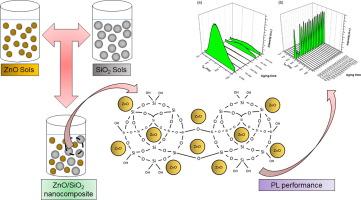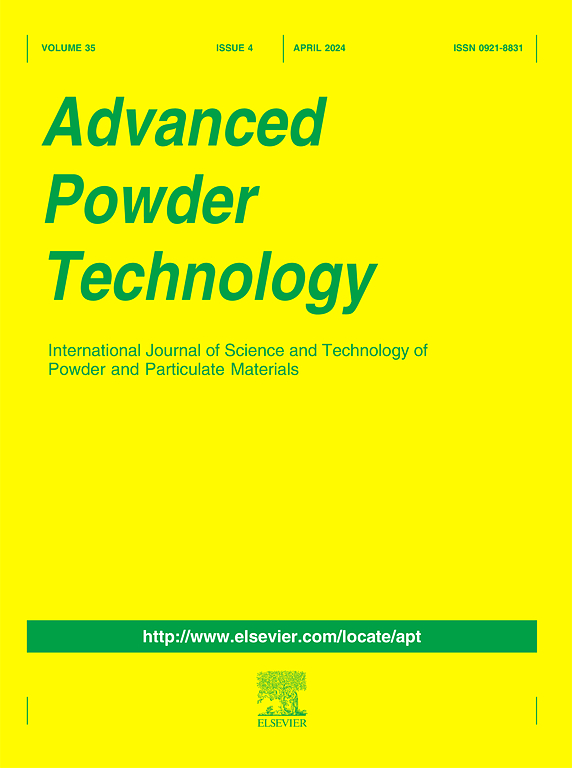不含表面活性剂的二氧化硅纳米流体稳定的可调氧化锌量子点 (QDs) 的可见发光光谱特性
IF 4.2
2区 工程技术
Q2 ENGINEERING, CHEMICAL
引用次数: 0
摘要
本研究探讨了经阳离子表面活性剂十六烷基三甲基溴化铵(CTAB)稳定并嵌入硅藻土网络的氧化锌量子点(QDs)的物理特性对其作为光材料的光学特性的影响。利用含乙醇分散剂的溶胶-凝胶法合成的氧化锌 QDs 根据稳定剂类型的不同显示出不同的光学特性。当使用阳离子表面活性剂进行稳定时,ZnO QDs 在可见光谱中发出光致发光(PL),特别是在 536 纳米波长处发出绿色光,带隙能为 2.31 eV,这与纯 ZnO QDs 非常相似。然而,这些阳离子表面活性剂稳定的 ZnO QDs 在最初的 24 小时内显示出明显的 PL 强度下降,降幅达 86%,表明其保存期限有限。另一种方法是在透明固体基质中使用二氧化硅纳米流体作为稳定剂,显示出对氧化锌纳米粒子尺寸的稳定作用,即使铝凝胶复合体的体积扩大到微米尺寸,其尺寸仍保持在 10 纳米以下。本研究在 ZnO/SiO2 纳米复合材料形成过程中改变了 ZnO 的浓度和二氧化硅纳米流体的 pH 值,这对光致发光性能、透射率和稳定性产生了显著影响。在环境温度下保存 14 天后,硅稳定的 ZnO QDs 在 pH 值为 10 的硅纳米流体中的光致发光强度比阳离子表面活性剂 CTAB 稳定的 ZnO QDs 高出一千倍以上。这种增强凸显了二氧化硅纳米流体作为稳定剂的功效,其 pH 值可以调整,以优化特定可见光光谱内的聚光辐射,从而展示了定制光材料应用的潜力。本文章由计算机程序翻译,如有差异,请以英文原文为准。

Behavior of tunable ZnO quantum dots (QDs) stabilized by surfactant-free silica nanofluids in their visible luminescence spectra
This research explores the impact of ZnO quantum dots (QDs) physical characteristics, stabilized by cationic surfactants hexadecyltrimethylammonium bromide (CTAB) and embedded in silica alcogel networks, on their optical properties as photomaterials. Using the sol–gel method with ethanol dispersants, the synthesized ZnO QDs displayed varying optical characteristics based on the stabilizer type. When stabilized with cationic surfactants, the ZnO QDs exhibited photoluminescence (PL) emissions in the visible spectrum, specifically green emission at 536 nm with a band gap energy of 2.31 eV, which closely resembled those of pure ZnO QDs. However, these cationic surfactant-stabilized ZnO QDs demonstrated a significant PL intensity decline of 86 % within the first 24 h, suggesting a limited shelf life. As an alternative, silica nanofluids were utilized as stabilizers within a transparent solid matrix, showing a stabilizing effect on the ZnO nanoparticle size, which remained under 10 nm even as the alcogel composite bulk scaled to micrometer dimensions. This study varied the concentration of ZnO and the pH of silica nanofluids during the ZnO/SiO2 nanocomposite formation, which significantly influenced the photoluminescence performance, transmittance, and stability. After being storage for 14 days at ambient temperature, the silica-stabilized ZnO QDs remarkably showed a PL emission intensity more than a thousand times higher at a pH 10 of silica nanofluids than ZnO QDs stabilized by the cationic surfactant CTAB. This enhancement underscores the efficacy of silica nanofluids as stabilizers, whose pH can be adjusted to optimize PL emissions within specific visible light spectra, showcasing potential for tailored photomaterial applications.
求助全文
通过发布文献求助,成功后即可免费获取论文全文。
去求助
来源期刊

Advanced Powder Technology
工程技术-工程:化工
CiteScore
9.50
自引率
7.70%
发文量
424
审稿时长
55 days
期刊介绍:
The aim of Advanced Powder Technology is to meet the demand for an international journal that integrates all aspects of science and technology research on powder and particulate materials. The journal fulfills this purpose by publishing original research papers, rapid communications, reviews, and translated articles by prominent researchers worldwide.
The editorial work of Advanced Powder Technology, which was founded as the International Journal of the Society of Powder Technology, Japan, is now shared by distinguished board members, who operate in a unique framework designed to respond to the increasing global demand for articles on not only powder and particles, but also on various materials produced from them.
Advanced Powder Technology covers various areas, but a discussion of powder and particles is required in articles. Topics include: Production of powder and particulate materials in gases and liquids(nanoparticles, fine ceramics, pharmaceuticals, novel functional materials, etc.); Aerosol and colloidal processing; Powder and particle characterization; Dynamics and phenomena; Calculation and simulation (CFD, DEM, Monte Carlo method, population balance, etc.); Measurement and control of powder processes; Particle modification; Comminution; Powder handling and operations (storage, transport, granulation, separation, fluidization, etc.)
 求助内容:
求助内容: 应助结果提醒方式:
应助结果提醒方式:


